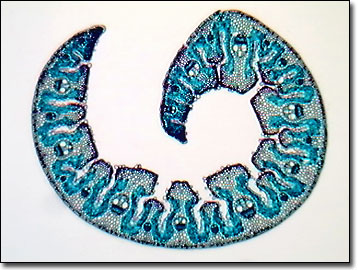Brightfield Digital Image Gallery
American Beachgrass
American beachgrass grows naturally on dunes that border beaches along the Atlantic and Gulf of Mexico coastlines, but does not fare well in the richer, darker, and less oxygenated soils of the inland marshes and the bay sides of barrier islands. Beachgrass stands up well against the continuous salt spray of the crashing waves and ocean breeze and the blazing heat of the summer sun on the dune sands.

View a high magnification image of American beachgrass (thin section).
Most importantly for beach lovers and coastal dwellers, the roots and horizontal runners or rhizomes of beachgrass are extensive and massive. In addition to diving below the sand, seeking fresh water for life support, the root mass stabilizes the dunes. Climbing or driving on vegetated dunes can kill the beachgrass and destabilize the dunes, leading to sandstorms and dune blowouts. In severe cases, particularly during hurricanes and strong coastal storms with destructive onshore winds and waves, massive beach erosion and significant island and mainland coastal economic damage may occur if beachgrass stands are removed or damaged.
Well adapted to coastal dune life, on the hottest days, the beachgrass leaves curl inward to reduce the area exposed to direct and reflected solar light and radiant heat. In this manner, beachgrasses conserve vital freshwater resources. Beach restoration projects that are most successful in terms of longevity, cost-effectiveness, and side benefits to associated wildlife incorporate beachgrass plantings with dune stabilization and restrictions to human disturbances. Although attractive to affluent summer residents and vacationers, barrier island and other forms of coastal development in the United States have often destroyed the tiny and often overlooked beachgrass plants. This oversight has resulted in storm, flood, and erosion damage to houses and public infrastructure totaling in the billions of dollars, and has inflated coastal homeowner insurance costs.
Contributing Authors
Cynthia D. Kelly, Thomas J. Fellers and Michael W. Davidson - National High Magnetic Field Laboratory, 1800 East Paul Dirac Dr., The Florida State University, Tallahassee, Florida, 32310.
BACK TO THE BRIGHTFIELD IMAGE GALLERY
BACK TO THE DIGITAL IMAGE GALLERIES
Questions or comments? Send us an email.
© 1995-2025 by Michael W. Davidson and The Florida State University. All Rights Reserved. No images, graphics, software, scripts, or applets may be reproduced or used in any manner without permission from the copyright holders. Use of this website means you agree to all of the Legal Terms and Conditions set forth by the owners.
This website is maintained by our
Graphics & Web Programming Team
in collaboration with Optical Microscopy at the
National High Magnetic Field Laboratory.
Last Modification Friday, Nov 13, 2015 at 01:19 PM
Access Count Since September 17, 2002: 13749
Visit the website of our partner in introductory microscopy education:
|
|
